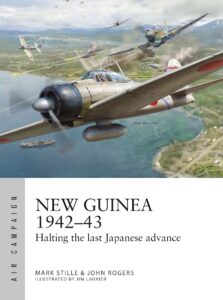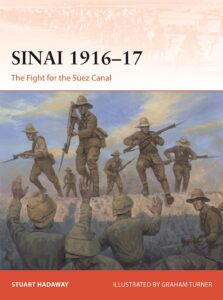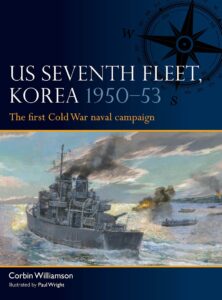
by RNS | Sep 21, 2025 | Beating Tsundoku
Mark Stille & John Rogers, New Guinea 1942-43 (Osprey, 2025)
Many historians highlight turning points that determine how campaigns are won and lost. But some, if not most, campaigns do not fit that model. They are attritional, with their outcomes dependent on resource allocation and a myriad of small victories and setbacks. The air campaign over New Guinea in 1942 seems to fit the latter model. Mark Stille and John Rogers narrate the events of that campaign and analyse its conduct and the reasons for Allied success and Japanese failure.
In early 1942, Japan still has imperial conquest on its mind. Control of Papua New Guinea formed an important part of the imperial strategy. The Allies needed New Guinea to defend Australia. For both of them, distance and environment presented tactical headaches. Stille surveys the respective capabilities of both sides. For the Japanese, both the navy and army air forces would be involved in the fighting. Their main warplane was the famous, or infamous, Zero. The Allies opened with an aerial disadvantage. The Australians in particular had very little to play with, and the US prioritized Europe, reducing their effectiveness in the Pacific. Stille notes that both would improve through 1942. The campaign objectives come next, with a deeper dive into the strategies of both sides. Then we are into the narrative of the campaign.
Even while still consolidating its gains, Japan moved aggressively to reduce Port Moresby in January 1942. The opening engagements favoured the Japanese, with the Zeros dominating the skies. Spurious raiding from both sides turned into a battle of attrition from April. That did not favour the Japanese with more US forces coming on tap. Along the way, Stille connects his narrative to the broader strategic situation; for example, he considers the effects of the Battle of the Coral Sea, the Japanese invasion of Buna, and the Battle of the Bismarck Sea. Ultimately, the Allied superiority in logistics and tactical innovations turned the tide against the Japanese. Stille concludes that the Japanese contributed to their own demise, so much so that their defeat almost appeared inevitable.
New Guinea 1942-43 is an action-packed and informative introduction to the air war in that part of the Pacific theatre during a crucial phase in the war. Stille and Rogers clearly know their stuff, and their text is accompanied by many illuminating maps, photographs, and illustrations. My only criticism is that that the text needed a final edit: the alternative plan of reducing the font to fit all the text into the format did not help this reviewer’s aging eyes. Nevertheless, anyone interested in aerial warfare and the Pacific theatre will undoubtedly enjoy this book.

by RNS | Sep 12, 2025 | Beating Tsundoku
Stuart Hadaway, Sinai 1916-17 (Osprey, 2025)
The most popular description of World War I reflects the European Western Front of ‘mud and blood’ in the trenches. But that is far from the whole story, as Stuart Hadaway narrates in this illuminating Campaign series book from Osprey. The theatre Hadaway is interested in is the desert campaign fought between the Commonwealth forces and the Ottomans for control of the Suez Canal, the ‘jugular vein of the British Empire’.
After retelling the background story of the Ottoman attack on the Suez Canal in January 1915, which was repulsed by the Indian garrison, Hadaway introduces the Egyptian Expeditionary Force, made up of British and Commonwealth troops, tasked with developing a buffer zone in the Sinai for the Canal. Hadaway considers the opposing commanders: the Ottoman Ahmed Djemal Pasha and General von Kressenstein, his German staff officer, and for the Commonwealth forces, Sir Archibald Murray, Sir Herbert Lawrence, and Sir Harry Chauvel. Assessing the forces follows. The Ottoman organisation changed under the exigencies of war, and the mostly peasant army faced manpower and logistical problems. They were assisted by specialised troops from their European allies. Hadaway notes the esprit-de-corps of the British and Commonwealth forces, the usefulness of their cavalry across great distances, and the lack of potency in the air, and he makes a special mention of the Egyptian Labour Corps without whom the army would have difficulty advancing or supplying itself. As for strategies, ultimately the Ottomans wanted to liberate Egypt, but they needed to control the Sinai. They ended up doing neither. The British needed to defend the Suez Canal, but initial victories led them to underestimate the Ottomans; a story that Hadaway goes on to narrate.
You cannot fight effectively in the desert without proper logistical support, and that is where Hadaway begins his narrative. He compares the British and Ottoman supply difficulties, the focus of which would be the Suez Canal. The Ottomans struck first, at Qatia, on 23 April 1916, leading to the Commonwealth forces digging in at Romani. The Ottomans attacked again in early August. After hard and often confusing fighting, the Ottomans retreated with the Commonwealth forces in pursuit. They in turn would find themselves blocked at Bir El Mazar in mid-September. Nevertheless, the advance continued. Haddaway follows the action to El Arish and Magdhaba, which fell in December 1916. By early 1917, the Commonwealth forces had achieved their strategic goal of securing the Suez Canal. Although severe setbacks awaited, Hadaway concludes here; the Sinai campaign was over.
The Sinai campaign of 1916 and 1917 may be less well known among casual readers of World War I, but Hadaway’s book should bring it to a wider audience. It is not easy to clearly narrate military campaigns fought in a desert, but Haddaway manages it very well by blending operational information with the human factor. He also weights his narrative effectively, giving due credit to the considerable work ‘behind the scenes’ in addition to the front-line fighting. With the assistance of Osprey’s customary excellent maps and illustrations, Hadaway’s book should turn more attention to this oft ignored World War I theatre.

by RNS | Sep 2, 2025 | Beating Tsundoku
Corbin Williamson, US Seventh Fleet Korea 1950-53 (Osprey, 2025)
Some still refer to the Korean War as the Forgotten War. If it is remembered, it is the ground war that garners most interest followed by the air war in the new jet age. What is too often overlooked is the role of the various navies that made up the UN force at sea. In this book, Corbin Williamson addresses that omission with a particular focus on the most powerful fleet in the world at the time, the US 7th Fleet.
Williamson begins with an overview of the 7th Fleet after World War II. He notes that the fleet remained busy even while US defence cuts took hold and foreign policy focus shifted from the Pacific to Europe. There was also internal dissension between the Air Force and the Navy over how US airpower would function. In the meantime, tensions arose on the Korean peninsula with the threat of a communist takeover. The 7th Fleet held exercises with the Royal Navy in March 1950, but the real action was just around the corner with the communist assault on the Republic of Korea.
An analysis of the 7th Fleet follows the narrative preamble. Williamson surveys the ships, including the carriers, battleships, cruisers, and destroyers, before moving onto the naval warplanes and helicopters. Williamson examines how the fleet operated, focusing on command, control, and communications. Here we find that the Navy was split into two commands in the Pacific then into three groups as the demands became clearer – Williamson helpfully includes an organisational chart to show the various changes. Williamson next describes the problems in communications caused by the increase in wartime radio traffic. The Korean War required a change in US naval doctrine and an increased need for manpower. Williamson also covers naval intelligence and logistics.
Knowing how the navy operated helps us understand what they did in combat. Williamson narrates the defence of the Pusan Perimeter in 1950. Overall naval supremacy was established quickly in the Korean War, but the main naval activity was providing air support for ground troops. Perhaps the most famous incident in the war was the landings at Inchon, facilitated by the Navy and let us not forget the pivotal role of the US Marines. Williamson adds the daring bombardment of Chinnampo to his narrative along with other evacuations of troops when the Chinese flooded over the Yalu River. In 1951 and 1952, the Navy helped interdict Chinese communications with varying degrees of success. Later, to provide an edge in peace negotiations, the Navy increased its attacks on infrastructure.
This is an informative book that adequately supports Williamson’s conclusion that the actions of the 7th Fleet demonstrated the continuing utility of the navy in a time of jets and missiles. Williamson does a good job of explaining how the fleet operated, and he takes care to include the valuable support of other national fleets in this United Nations operation. There is not much in the way of significant events to cover in this war, but Williamson brings out those that were important while describing the fleet’s almost continuous role in supporting the action on the ground. Osprey adds its usual flavourful artwork and graphics to produce a useful survey of this often overlooked aspect of an often overlooked war.




